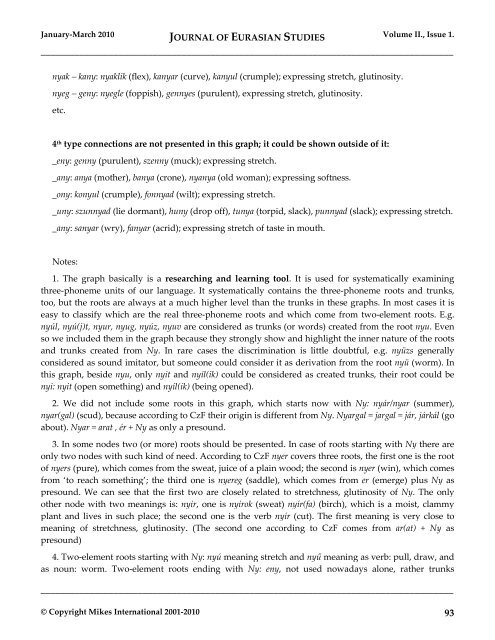EurasianStudies_0110..
EurasianStudies_0110..
EurasianStudies_0110..
You also want an ePaper? Increase the reach of your titles
YUMPU automatically turns print PDFs into web optimized ePapers that Google loves.
January-March 2010 JOURNAL OF EURASIAN STUDIES Volume II., Issue 1.<br />
_____________________________________________________________________________________<br />
nyak – kany: nyaklik (flex), kanyar (curve), kanyul (crumple); expressing stretch, glutinosity.<br />
nyeg – geny: nyegle (foppish), gennyes (purulent), expressing stretch, glutinosity.<br />
etc.<br />
4 th type connections are not presented in this graph; it could be shown outside of it:<br />
_eny: genny (purulent), szenny (muck); expressing stretch.<br />
_any: anya (mother), banya (crone), nyanya (old woman); expressing softness.<br />
_ony: konyul (crumple), fonnyad (wilt); expressing stretch.<br />
_uny: szunnyad (lie dormant), huny (drop off), tunya (torpid, slack), punnyad (slack); expressing stretch.<br />
_any: sanyar (wry), fanyar (acrid); expressing stretch of taste in mouth.<br />
Notes:<br />
1. The graph basically is a researching and learning tool. It is used for systematically examining<br />
three-phoneme units of our language. It systematically contains the three-phoneme roots and trunks,<br />
too, but the roots are always at a much higher level than the trunks in these graphs. In most cases it is<br />
easy to classify which are the real three-phoneme roots and which come from two-element roots. E.g.<br />
nyúl, nyú(j)t, nyur, nyug, nyúz, nyuv are considered as trunks (or words) created from the root nyu. Even<br />
so we included them in the graph because they strongly show and highlight the inner nature of the roots<br />
and trunks created from Ny. In rare cases the discrimination is little doubtful, e.g. nyüzs generally<br />
considered as sound imitator, but someone could consider it as derivation from the root nyü (worm). In<br />
this graph, beside nyu, only nyit and nyíl(ik) could be considered as created trunks, their root could be<br />
nyi: nyit (open something) and nyíl(ik) (being opened).<br />
2. We did not include some roots in this graph, which starts now with Ny: nyár/nyar (summer),<br />
nyar(gal) (scud), because according to CzF their origin is different from Ny. Nyargal = jargal = jár, járkál (go<br />
about). Nyar = arat , ér + Ny as only a presound.<br />
3. In some nodes two (or more) roots should be presented. In case of roots starting with Ny there are<br />
only two nodes with such kind of need. According to CzF nyer covers three roots, the first one is the root<br />
of nyers (pure), which comes from the sweat, juice of a plain wood; the second is nyer (win), which comes<br />
from ‘to reach something’; the third one is nyereg (saddle), which comes from er (emerge) plus Ny as<br />
presound. We can see that the first two are closely related to stretchness, glutinosity of Ny. The only<br />
other node with two meanings is: nyir, one is nyirok (sweat) nyír(fa) (birch), which is a moist, clammy<br />
plant and lives in such place; the second one is the verb nyír (cut). The first meaning is very close to<br />
meaning of stretchness, glutinosity. (The second one according to CzF comes from ar(at) + Ny as<br />
presound)<br />
4. Two-element roots starting with Ny: nyú meaning stretch and nyű meaning as verb: pull, draw, and<br />
as noun: worm. Two-element roots ending with Ny: eny, not used nowadays alone, rather trunks<br />
_____________________________________________________________________________________<br />
© Copyright Mikes International 2001-2010 93

















